More actions
There are seven major iterations of the iPod nano.
Fire warning: Most iPod nano designs use a tight unibody case, which is a risk for aging lithium-ion batteries. An iPod nano with expanded battery often exhibits a "black spot" on the display. Additionally, the iPod nano (1st generation) was recalled in 2011 due to a fire risk from some batteries used.[1]
iPod nano
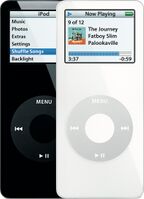
The iPod nano was introduced as Apple's replacement for the iPod mini. Through the use of flash storage rather than a mechanical hard drive, the new product line achieves a thinner, smaller, and lighter form factor. Unlike all subsequent iPod nano models, the first generation uses a glossy plastic front plate with chrome back.
General:
- Release Date:
- Color: Black/White
Hardware:
- Battery: 340 mAh Li-Po
- CPU Specs:
- Processor: PortalPlayer PP5021C
- CPU Speed: 90 MHz
- RAM: 32 MiB DRAM
- Storage: 1 GB/2 GB/4 GB flash storage
- Connectivity:
- 3.5mm headphones (stereo)
- 30-pin Connector - FireWire (charging only) and USB (charging and data)
- Interface:
- 176×132 1.5″ color display
- Touch-sensitive click wheel with navigation buttons
Identifiers:
- Codename: M26
- Firmware identifiers: 14 (2 GB/4 GB), 17 (1 GB)
- Gestalt identifiers:
0x000C0005,0x000C0006 - USB product identifier:
0x120A
iPod nano (2nd generation)
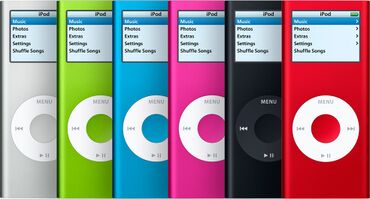
The second-generation iPod nano reuses the same form factor as its predecessor, but changes the case material to an aluminium unibody. It is notable for being the first iPod to switch from PortalPlayer to Samsung S5L SoCs, much like the iPhone, which had not yet been announced at the time.
General:
- Release Date: 12 September 2006[4]
- Colors:
- 2 GB: Silver
- 4 GB: Silver, Green, Blue, Pink, PRODUCT(RED)
- 8 GB: Black, PRODUCT(RED)
Hardware:
- Battery: 370 mAh Li-Po
- CPU Specs:
- Processor: Samsung S5L8701
- CPU Speed: ? MHz
- RAM: 32 MiB DRAM
- Storage: 2 GB/4 GB/8 GB flash storage
- Connectivity:
- 3.5mm headphones (stereo)
- 30-pin Connector - FireWire (charging only) and USB (charging and data)
- Interface:
- 176×132 1.5″ color display
- Touch-sensitive click wheel with navigation buttons
Identifiers:
iPod nano (3rd generation)
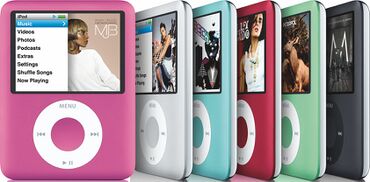
This unique model makes use of a design mimicking a miniaturised iPod classic (6th generation), which it was released alongside. The software design and implementation is close to, if not identical to, the iPod classic. Its wider design than other iPod nano generations brings it the colloquial name of "fat iPod nano".
General:
- Release Date: 5 September 2007[5]
- Colors:
- Initial 4 GB: Silver
- Initial 8 GB: Silver, Blue, Green, Black, PRODUCT(RED)
- 22 January 2008 refresh 8 GB: Silver, Pink, Blue, Green, Black, PRODUCT(RED)[6]
Hardware:
- Battery: 400 mAh Li-Po
- CPU Specs:
- Processor: Samsung S5L8702
- CPU Speed: ? MHz
- RAM: 32 MiB DRAM
- Storage: 4 GB/8 GB flash storage
- Connectivity:
- 3.5mm headphones (stereo)
- 30-pin Connector - FireWire (charging only) and USB (charging and data)
- Interface:
- 320×240 2″ color display
- Touch-sensitive click wheel with navigation buttons
Identifiers:
iPod nano (4th generation)

Reverting to the form factor of prior generations, the iPod nano (4th generation) additionally introduces a curved design and higher-resolution display, rotated vertically from its predecessor. The color selection was greatly increased with this generation, playing a prominent part in the product's advertising. It uses a variant of the Samsung S5L8720 as its SoC, which it shares in common with the iPod touch (2nd generation).
Unusually, a 4 GB model was sold in markets such as Europe by third-party retailers. Apple provided a statement to media outlet Pocket-lint that "We made a limited number of 4GB iPod nanos for some international markets, but this is not one of our main configurations."[7] It is not otherwise acknowledged by Apple as a configuration of this generation, leading to speculation that it may have been a last-minute change to the 4th generation storage options to compete with the new Zune lineup announced on 8 September 2008.[8]
General:
- Release Date: 9 September 2008[9]
- Colors: Silver, Black, Purple, Blue, Green, Yellow, Orange, Pink, PRODUCT(RED)
Hardware:
- Battery: 240 mAh Li-Po
- CPU Specs:
- Processor: Samsung S5L8720
- CPU Speed: ? MHz
- RAM: 32 MiB DRAM
- Storage:
- 8 GB/16 GB flash storage
- 4 GB flash storage: limited run sold in some markets[7]
- Connectivity:
- 3.5mm headphones (stereo)
- 30-pin Connector - USB (charging and data)
- Interface:
- 240×320 2″ color display
- Touch-sensitive click wheel with navigation buttons
- Sensors:
- Accelerometer
Identifiers:
iPod nano (5th generation)
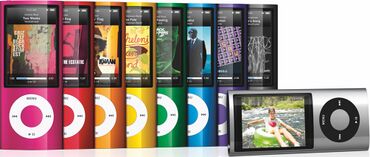
This refresh of the fourth-generation design introduces a camera and microphone, in addition to a taller display, and built-in FM radio tuner. The case design is tweaked to use a polished finish. As with the prior generation, the refreshed color selection played a prominent part in the product's advertising. An integrated FM radio receiver is introduced to the iPod for the first time, superseding the separate iPod Radio Remote accessory.
General:
- Release Date: 13 September 2009[10]
- Colors: Black, Silver, Purple, Pink, Yellow, Blue, Green, Orange, PRODUCT(RED)
Hardware:
- Battery: 240 mAh Li-Po
- CPU Specs:
- Processor: Samsung S5L8730
- CPU Speed: ? MHz
- RAM: 64 MiB DRAM
- Storage: 8 GB/16 GB flash storage
- Connectivity:
- 3.5mm headphones (stereo)
- 30-pin Connector - USB (charging and data)
- FM radio receiver
- Interface:
- 240×376 2.22″ color display
- Touch-sensitive click wheel with navigation buttons
- Sensors:
- Accelerometer
Identifiers:
iPod nano (6th generation)

Perhaps the most unique of iPod designs, the sixth-generation iPod nano introduces a touch screen as a replacement for the click wheel. It uses a square form factor, enabling album art to be displayed full-screen. It runs a refreshed iPod operating system, making use of design elements copied from iOS 4, including a "home screen" of icons for major features. It features a belt clip, and does not retain the camera and microphone added in its predecessor. Replacing the always-on clock display feature found on all LCD-based iPods to date, this generation introduces graphical clock faces, including Disney-licensed designs.
It is not to be confused with the iPod shuffle (4th generation), which uses a similar square design with belt clip, but with fixed buttons rather than a display.
General:
- Release Date: 1 September 2010[11]
- Colors: Silver, Graphite, Blue, Green, Orange, Pink, PRODUCT(RED)
Hardware:
- Battery: 105 mAh Li-Po
- CPU Specs:
- Processor: Samsung S5L8723
- CPU Speed: ? MHz
- RAM: 64 MiB DRAM
- Storage: 8 GB/16 GB flash storage
- Connectivity:
- 3.5mm headphones (stereo)
- 30-pin Connector - USB (charging and data)
- FM radio receiver
- Interface:
- 240×240 1.55″ color touchscreen display
Identifiers:
iPod nano (7th generation)
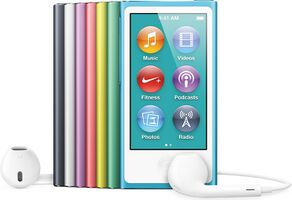
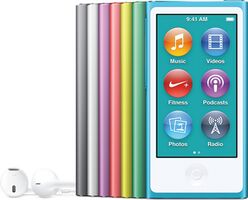
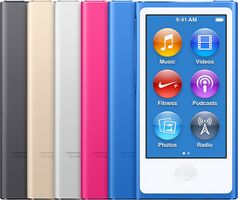
The final iPod nano generation continues the iOS-inspired design approach in a vertical design, taking it further by introducing a home button. It introduces the Lightning connector to the iPod line, which debuted on the iPhone 5 released at the same time. Bluetooth 4.0 connectivity was introduced to support wireless headphones. It was sold until the iPod nano and iPod shuffle lines were discontinued on 27 July 2017.
General:
- Release Date:
- Initial: 12 October 2012[12]
- Rev A: 15 July 2015
- Colors:
- Initial: Slate, Silver, Pink, Yellow, Green, Blue, Purple, PRODUCT(RED)
- 10 September 2013 refresh: Space Gray, Silver, Pink, Yellow, Green, Blue, Purple, PRODUCT(RED)
- Rev A: Space Gray, Silver, Gold, Pink, Blue, PRODUCT(RED)
Hardware:
- Battery: 220 mAh Li-ion
- CPU Specs:
- Processor: Samsung S5L8740
- CPU Speed: ? MHz
- RAM: 64 MiB DRAM
- Storage: 16 GB flash storage
- Connectivity:
- 3.5mm headphones (stereo)
- Lightning Connector - USB (charging and data)
- Bluetooth 4.0
- FM radio receiver
- Interface:
- 240×432 2.5″ color touchscreen display
Identifiers:
References
- http://www.ipodlinux.org/Generations/
- https://github.com/Rockbox/rockbox/blob/58b2e457824dc93916233627b98614409e5f258d/utils/mks5lboot/ipoddfu.c#L114
- https://usb-ids.gowdy.us/read/UD/05ac [Archived 2023-03-30 at the Wayback Machine]
- ^ https://web.archive.org/web/20111112055100/http://www.apple.com/support/ipodnano_replacement/
- ^ https://www.apple.com/newsroom/2005/09/07Apple-Introduces-iPod-nano/
- ^ https://www.apple.com/newsroom/2006/02/07Apple-Unveils-New-1GB-iPod-nano-at-149/
- ^ https://www.apple.com/newsroom/2006/09/12Apple-Introduces-the-New-iPod-nano/
- ^ https://www.apple.com/newsroom/2007/09/05Apple-Introduces-All-New-iPod-nano/
- ^ https://www.apple.com/newsroom/2008/01/22Apple-Adds-Pink-to-the-iPod-nano-Lineup/
- ^ a b https://web.archive.org/web/20150201223943/http://www.pocket-lint.com/news/89855-new-nano-spotted-4gb-models
- ^ https://www.ilounge.com/index.php/backstage/comments/the-why-behind-the-4gb-fourth-gen-ipod-nano
- ^ https://www.apple.com/newsroom/2008/09/09Apple-Introduces-New-iPod-nano/
- ^ https://www.apple.com/newsroom/2009/09/09Apple-Introduces-New-iPod-nano-With-Built-in-Video-Camera/
- ^ https://www.apple.com/newsroom/2010/09/01Apple-Reinvents-iPod-nano-With-Multi-Touch-Interface/
- ^ https://www.apple.com/newsroom/2012/09/12Apple-Introduces-New-iPod-touch-iPod-nano/
